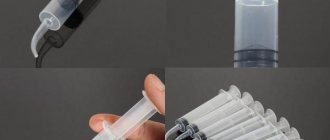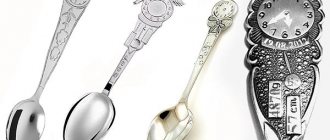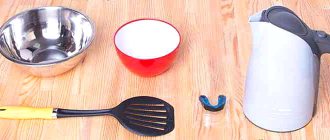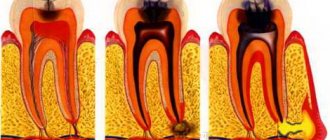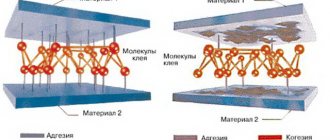Implant abutment: what is it, the functional purpose of the element
Dental implants are a special type of structure that is used in dentistry to restore lost teeth. The design consists not only of the implant itself - a titanium rod implanted into the bone tissue of the jaw; it includes several elements at once, including an abutment, which can be called an adapter between the implant and the crown.
In the article we will talk in detail about what an abutment is, what functional tasks this element of the implantation system solves, and what types of abutments exist.
Calculate the cost of treatment by taking a short test in 20 seconds!
Do not delay your treatment, because in this matter time plays against us.
What it is
For many years, this element has been successfully used in dentistry for dental implantation. But at first, doctors installed only bridges, and only then another method appeared that did not involve violating the integrity of neighboring healthy teeth. A small part that rises above the gum is the abutment.
Implant and titanium abutment inserted into it
Why is it needed? As noted earlier, this is a kind of connecting part that connects the crown to the pin, which plays the role of a tooth root. For reliable and convenient fixation of the visible part of the crown on the base, a special element, some kind of adapter, is needed.
Screw prostheses
The abutment installation procedure should be started only when the gums have completely healed after implantation. There is a wide variety of these elements, as well as methods for installing them. In addition, abutments can be made from various materials, which should be taken into account when choosing.
What is a dental implant abutment?
Dental implantation is a progressive technology for restoring lost teeth, but ordinary people have too superficial an understanding of how the operation of implantation is carried out and, even more so, of the structural design of dental implants. The abutment is one of the main parts of the implant system and its purpose is to connect the implanted titanium rod to the dental crown.
It is impossible to install a crown on an implant without an abutment; in addition, the service life of the prosthesis, its functionality, and aesthetic appearance depend on this element. Just a few years ago, manufacturers of implantation systems offered only one option for abutments - a standard design. These days, dental brands produce entire lines of abutments, which may differ from each other in appearance, shape, and production material.
We will talk in detail about the types of abutments in the next section of the article.
Installation Features
Simply implanting or screwing in a link will not be enough, because reliability and high strength depend on good fixation of the product. Poor installation can lead to the crown becoming loose over time or falling off altogether. In dentistry, two methods are used for reliable fastening, both of which are suitable for all types of abutments.
Titanium abutments
Method number 1. Screw fastening
Its peculiarity lies in the screwing of a dental crown, in which you first need to make a small hole. After this, the doctor begins installation, and then the shaft with the screw is sealed. The use of this fastening method involves making a hole in the part of the dental crown that receives the least amount of load.
Dental implant device
Method number 2. Cement fastening
It differs from the previous method in that a hole is not drilled in the crown, but the fastening itself occurs using a special medical fixing liquid - cement. With its help, the doctor attaches the implant to the abutment. This method is used only when screwing cannot be carried out due to the likelihood of damaging the crown or prosthesis, as a result of which the aesthetics of the product may deteriorate.
- How to insert teeth if there is no root
Example of cement fastening
The choice of attachment method is made by the attending physician individually in each case, taking into account the characteristics of the patient’s body, the quality of the products used, as well as the peculiarities of the implantation being performed.
If we talk about choosing an abutment, then each person has the right to independently decide what he likes best. But still, doctors do not recommend choosing plastic products, despite their attractive price, since such abutments are most often used only as temporary measures. The procedure itself is quite simple, so there is no need for long-term adaptation of the patient to a foreign body, as can happen when installing removable dentures. Depending on the location of the teeth that need to be replaced, a fixing element is selected.
Custom abutments
Classification of abutments into types, overview of the characteristics of different types of structures
Abutments are classified according to a set of performance characteristics, as well as by area of application. Let's look at the most popular types of abutments in modern dental implantation.
Standard abutments
They are universal designs, manufactured according to templates.
Standard abutments are produced in different sizes, diameters, and various shapes. Suitable for use in a wide variety of clinical situations. The price of standard abutments is quite reasonable; if necessary, it is easy to remove and replace the structure with a new one. With all the advantages, standard design abutments also have a number of disadvantages:
They do not provide the opportunity to obtain ideal aesthetics in the gum area;
May not be suitable for a patient with anomalies in the structure of the dental system;
When choosing a standard abutment, an additional and thorough quality check is definitely recommended.
Custom abutments
This type of construction is so called because the abutment is made individually for each patient.
To produce an individual abutment, a virtual model of the jaw in 3D format is used, and therefore the finished abutment will take into account all the anatomical features of the patient’s dental system. Pure titanium is most often used for the manufacture of structures; they can also be made from zirconium dioxide. The advantages of individual abutments include the following characteristics:
High quality, strict compliance with the characteristics of the anatomical structure of the jaw;
Improved aesthetics and functionality;
A tighter and better fit to the gum line, which eliminates the need for additional manipulations with sensitive tissues of the oral cavity;
There is only one drawback of individual abutments - high cost, but it is fully compensated by the benefits that the patient can receive by choosing abutments made personally for him.
Angled abutments
Used for installation on implants implanted at a non-standard angle. Angled abutments are in demand when performing implantation in patients with a non-standard structure of the dental system. Thanks to the unique type of design, which provides for a certain angle of inclination, it is possible to achieve the most durable connection between the implant and the crown.
Ball abutments
Abutments of this type are spherical in shape and are used during mini-implantation operations.
A conditionally removable denture is usually fixed on spherical abutments. Separate types of products are temporary and solid abutments. The first type of abutment is a plug that is placed on the implanted implant and contributes to the process of forming an aesthetic relief of the gums at the site of the operation. After the titanium rod has healed, the temporary abutment is removed.
In one-stage implantation, systems can be used in which the implant and abutment act as a single whole. After implantation of such an implant, a temporary crown is immediately placed on it.
Abutment classification
There are several types of abutments that are actively used in modern dentistry. Let's look at the most common of them.
Table. Main types of abutments.
- Gum former during implantation: what is it?
| Species name, photo | Description |
| Globular | It is made in the form of a round element and is used in dental practice for removable prosthetics. Ball-shaped abutments are very popular due to their ease of installation and high reliability. |
| Straight | This is a more practical type of abutment, most often used in cases where the dental structure requires a straight line. Basically, doctors choose straight elements for prosthetics of the frontal zone. |
| Angular | There is another name for an angular abutment - multiunit. It is used in rare cases when the implant is not installed at a right angle, as is usually the case. There can be many reasons for non-compliance with the 90º angle, so in such cases it is necessary to properly ensure the transition between the implant and the dental crown. |
| Standard | The most common type of abutment, which includes a wide variety of required sizes, shapes and lengths. This allows you to perform inexpensive, but quite good and high-quality prosthetics. |
| Heal former | In dental practice, it is also called a plug or temporary abutment. It is used during the healing period of the gums, thanks to which the size can be chosen more accurately. With the help of such a healing structure, it is possible to protect the implant from the penetration of various microorganisms into the resulting wound. This promotes rapid healing of soft tissues. |
Healing abutments and angular abutments
Plastic and spherical
Multiunit abutments
Abutment materials
The material used to produce abutments is important because it affects both the functionality of the prosthesis installed on the implant and the aesthetics of the implantation result. According to the material of manufacture, abutments are:
Titanium abutments
Titanium abutments are in greatest demand on the market due to the optimal combination of price and quality. They have excellent strength and reliability, but do not always provide the desired aesthetics, since titanium can noticeably show through the crown.
Zirconium abutments
They are the most expensive type of product, especially if you plan to use an individual zirconium abutment in the operation. Abutments made of zirconium dioxide provide impeccable aesthetics of restorations and have no analogues in terms of strength and durability.
Combined abutments
Manufactured from a titanium-zirconium alloy, they allow you to obtain the optimal combination of functionality and aesthetics, but the price of the products will be quite high, and in addition, combined abutments are presented in the lines of a small number of manufacturers of implantation systems.
Ceramic abutments
An ideal solution for patients with allergic reactions to metals and their alloys.
Ceramic abutments can be successfully used for implantation and restoration of teeth included in the smile zone. A separate type of product is plastic abutments - they are used exclusively for temporary restorations and are subsequently replaced by structures made of more durable and reliable materials.
What is the difference between screw fixation of crowns on implants and cement, which is better?
First, we need to explain that with cement fixation we have an implant, to which an abutment is screwed with a screw, and a crown is placed on top of it on top of the cement, in fact, exactly the same as on your own tooth. With screw fixation, a crown is immediately made and fixed directly to the implant (without an abutment) with the same screw. This leaves a hole in the crown for the screw, which is closed with a conventional light filling material.
What's better? This question is akin to what is better: Mercedes or BMW, Canon or Nikon, Mac OS or Windows, Gucci or Prada... You should not contrast one type of prosthetic fixation with another. Although even among very advanced dentists there are ardent fans of one method or another, defending their position on the preferable use of one method over another. In fact, in my opinion, both of them have an equal right to life and selective use in certain conditions. Each has its own pros and cons. And I believe that in this matter the choice is up to the individual doctor. If he justified his choice to you, and you internally agree with his arguments, then simply trust. Otherwise, you can get to the point where you try to advise the implantologist during the implantation operation how to hold the tip correctly, what drills to choose, what thread to sew with, etc. In general, this usually only happens to one type of patient... the dentists themselves, when they find themselves on the other side of the drill machine.
And yet, if such a question arises, then for particularly interested patients I will very briefly explain the disadvantages of each fixation method.
Installation and fixation of the abutment on the implant
If a one-stage implantation is carried out, then the implant and abutment are installed simultaneously and usually one-piece structures are used in this type of operation. After implantation of a titanium rod with an abutment, the implant is immediately loaded with a temporary crown. When carrying out implantation according to the classical protocol, the installation of all elements of the implantation system is divided into several successive stages:
1. General preparation for surgery (consultation, diagnosis, panoramic image, preliminary treatment, sanitation of the oral cavity);
2. Installation of an implant into the jaw bone. A gum former is placed on the implant - a temporary plug that allows you to achieve an attractive gum relief in the implantation area.
3. Installation of the abutment (performed after complete osseointegration of the implant);
4. Installation of the crown.
Fixation of the abutment to the implant can be done in two ways:
Using cement. The technique is simple and reliable, but requires care when removing excess cement mortar. There shouldn't be any left! In addition, if it is necessary to remove the crown, certain difficulties may arise;
Using screw type fasteners. A hole is made in the crown and the abutment screw is inserted through it. After installing the abutment and crown on it, the hole is masked with material and polished.
The screw fixation technology will help you easily remove the crown and abutment if necessary, but at the same time, the screw fastening of the abutment is inferior in reliability to traditional cement fastening, as it increases the risk of structure breakage.
Aftercare
After the dentist installs the abutments, they need to be properly cared for. You can’t just forget about them, because these products, like real teeth, require attention and careful treatment. The oral cavity should always be clean, especially the area around the supports. A few days after surgery, care can cause unpleasant and sometimes painful sensations, so you can use a toothbrush with soft bristles 2-3 days after installing the abutments.
Rules of care
Once the abutments are installed, no further surgeries will be performed. You just need to take a short break of 7-14 days so that the soft tissues have time to heal. Then you can begin installing dentures.
Crown on a standard abutment
Is it possible to replace an abutment that has become unusable?
Under certain circumstances, any element of the implantation system may become unusable. The titanium rod itself rarely needs to be replaced, since most manufacturers provide a lifetime guarantee for implants, and the material they produce is highly durable. But the abutment or crown may well fail and then it will be necessary to urgently replace it.
To quickly replace a broken abutment with a new design, it is recommended that you initially select an implantation system from a trusted manufacturer. It doesn’t have to be a premium brand - you can choose a system from a manufacturer that produces more budget-friendly, but still high-quality products. All recommendations on choosing the optimal implantation system can be given to you by the doctors of our clinic in Moscow - Vanstom. Our clinic is located in the center of Moscow, a 5-minute walk from the Baumanskaya metro station.
To make an appointment with a clinic specialist, dial our contact phone number or leave a request for a call back in the interactive form on the site. Vanstom dentistry in Moscow means modern technologies and high professionalism of doctors for the health of your teeth and the natural beauty of your smile!
Calculate the cost of treatment by taking a short test in 20 seconds!
Do not delay your treatment, because in this matter time plays against us.
Types of abutments
Standard abutments are produced by implant manufacturers. These are factory-made products with universal parameters, designed for standard installation conditions. They have a cylindrical shape, six lengths and two angles of inclination. Their main advantage is their lower price, which reduces the cost of the entire implantation procedure. At the moment, there is a fairly large selection of abutments produced for different implantation systems. The largest number of suitable abutments are offered for top implants. However, such factory blanks do not always fit perfectly with the crown. They can be mechanically corrected (polished), but this will not allow achieving a 100% result.
A custom abutment is made in the laboratory according to pre-taken measurements. To begin with, wax impressions are obtained, after which all data is scanned, entered into a computer and processed by a CAD/CAM system. This is special computer support for the design and manufacture of orthopedic structures. An individual abutment allows you to further recreate the natural shape of the tooth, as well as take into account the characteristics of the bite, the thickness of the bone tissue and other factors. Due to the complexity of manufacturing and more expensive materials, the price of the abutment is higher, which is its only drawback. However, if you choose not the most expensive implant, then the difference in the total cost will not be so significant.
Cost of abutments for dental implants
The price of an abutment depends on its type and material of manufacture. A standard titanium abutment will cost from 2,000 rubles, a titanium product made from an individual impression will cost more - from 6,000 rubles.
Zirconium individual abutments have the highest price - their cost can reach up to 30,000 rubles.
Usually, the patient is not told the price of the abutment separately, but the cost of implantation - that is, the operation of implanting a titanium rod with the installation of a gum former (if necessary) and then the abutment. Do you want to know the exact cost of implantation? Come to Vanstom, we are located at: Moscow, Baumanskaya metro station, st. Bakuninskaya, 17/28.
Why is a custom zirconium abutment better than a standard titanium abutment?
Its most important advantage is its complete anatomy and individuality. This is not only important from an aesthetic point of view, but also allows you to avoid getting fixing cement under the gum when fixing the crown to the abutment. This is a very important plus, because... imperceptible penetration of even a thin film of cement between a standard abutment and the gum can after some time cause inflammation - peri-imlantitis. It is extremely difficult to treat, and often this inflammation ends in the loss of bone around the implant, and, therefore, the “screw” itself.
And that's why this happens.
Due to the fact that a standard abutment is much narrower than a crown, when fixing the latter, excess cement is literally pressed into the space between the abutment and the gum (the risk zone is marked in the figure). This situation can be aggravated by the fact that, in an effort to disguise the metal of the abutment, the technician places a ledge below the level of the gum so that the edge of the crown goes deeper and completely covers the metal abutment. This will inevitably lead to cement getting into an area from where it can no longer be removed. The occurrence of inflammation in this case is often only a matter of time.
This is exactly the problem that occurred in this situation: a “top” implant + a standard titanium abutment + a metal-ceramic crown instead of the lower 6th tooth.
After removing the crown and exposing the abutment, cement leakage under the gum was determined, which led to peri-implantitis approximately 1.5 years after installation of the implant and the need for its removal.
These images show the current level of bone tissue around the implant (blue line) and what it was originally (red line). This bone defect is caused by inflammation of the tissue around the implant as a result of cement getting under the gum.
Abutment Manufacturers
Israeli, European and American manufacturers offer their products to the market. The standard abutment is constantly being improved, and the manufacturer is expanding its product range to satisfy patient needs.
Among the most popular manufacturers:
- Nobel BioCare (Switzerland), products are characterized by a lifetime guarantee, survival rate – 99%;
- Xive (Germany), characterized by high precision, has a patented thread system;
- Alpha Bio (Israel), inexpensive and high-quality products with a high degree of engraftment with soft tissues;
- Astra Tech (Sweden and USA), titanium abutments with a special coating containing fluoride, which improves hygiene and accelerates bone regeneration;
- Straumann (Switzerland), the material used is an alloy of zirconium dioxide and titanium, which reduces the healing time to 1 month.
What is a standard and custom abutment?
The standard design is a stamped finished shape offered by the manufacturer. Despite the wide product range, the mount does not always fit completely. An individual abutment is created based on an impression and panoramic tomography, and corresponds in shape and size.
Characteristics of a standard abutment.
- The options for customizing the mount are limited.
- The design is not always ideal aesthetically; the junction may be noticeable.
- In some cases, a gum former is required.
- Low cost.
Characteristics of a custom abutment.
- Full complementarity with other parts, possibility of correction.
- Highly aesthetic, the connection point is invisible.
- A tight fit reduces the likelihood of complications.
- High price.
It is important to know! Individual abutments are recommended for prosthetics of anterior teeth, since the installation accuracy reaches 0.1 mm.
Temporary abutment
The gum abutment, or so-called temporary abutment (TA), is similar to a cylinder with a tip. As a rule, it is installed when standard implantation is performed, after successful engraftment. Basically, the shaper is made of titanium, but sometimes ceramics and even zirconium are used. VA protects against damage and penetration of pathogenic bacteria into the gums. In addition, it protects soft tissues from deformation.
Only a correctly selected temporary abutment is able to fulfill the task assigned to it. Otherwise, it will interfere with the gum, cut it, and as a result, it will not be possible to obtain the desired format of soft tissue. The doctor selects the necessary parameters:
- size;
- shape;
- tilt angle.
This design must be made based on the individual characteristics of the permanent abutment.
How much can you use
Usually, VAs are worn for about six months, but often the soft tissues heal completely after half a month or a month, if there are no complications. You cannot remove the structure yourself, only a doctor. After removal, discomfort is possible: pain, swelling, bleeding. A day or two is within normal limits. After the gum contour is formed, the temporary structure is replaced with a permanent one, followed by fixation of the prosthesis.




